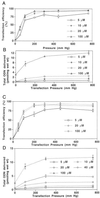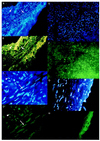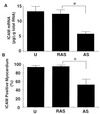Pressure-mediated oligonucleotide transfection of rat and human cardiovascular tissues
- PMID: 10339601
- PMCID: PMC26895
- DOI: 10.1073/pnas.96.11.6411
Pressure-mediated oligonucleotide transfection of rat and human cardiovascular tissues
Abstract
The application of gene therapy to human disease is currently restricted by the relatively low efficiency and potential hazards of methods of oligonucleotide or gene delivery. Antisense or transcription factor decoy oligonucleotides have been shown to be effective at altering gene expression in cell culture expreriments, but their in vivo application is limited by the efficiency of cellular delivery, the intracellular stability of the compounds, and their duration of activity. We report herein the development of a highly efficient method for naked oligodeoxynucleotide (ODN) transfection into cardiovascular tissues by using controlled, nondistending pressure without the use of viral vectors, lipid formulations, or exposure to other adjunctive, potentially hazardous substances. In this study, we have documented the ability of ex vivo, pressure-mediated transfection to achieve nuclear localization of fluorescent (FITC)-labeled ODN in approximately 90% and 50% of cells in intact human saphenous vein and rat myocardium, respectively. We have further documented that pressure-mediated delivery of antisense ODN can functionally inhibit target gene expression in both of these tissues in a sequence-specific manner at the mRNA and protein levels. This oligonucleotide transfection system may represent a safe means of achieving the intraoperative genetic engineering of failure-resistant human bypass grafts and may provide an avenue for the genetic manipultation of cardiac allograft rejection, allograft vasculopathy, or other transplant diseases.
Figures






Similar articles
-
Antisense oligodeoxynucleotides prevent acute cardiac allograft rejection via a novel, nontoxic, highly efficient transfection method.Transplantation. 1999 Sep 27;68(6):825-32. doi: 10.1097/00007890-199909270-00015. Transplantation. 1999. PMID: 10515383
-
Early growth response gene-1 decoy oligonucleotides inhibit vascular smooth muscle cell proliferation and neointimal hyperplasia of autogenous vein graft in rabbits.Interact Cardiovasc Thorac Surg. 2015 Jul;21(1):50-4. doi: 10.1093/icvts/ivv066. Epub 2015 Mar 27. Interact Cardiovasc Thorac Surg. 2015. PMID: 25820759
-
Delivery of oligodeoxynucleotides into human saphenous veins and the adjunct effect of ultrasound and microbubbles.Ultrasound Med Biol. 2005 Dec;31(12):1683-91. doi: 10.1016/j.ultrasmedbio.2005.08.002. Ultrasound Med Biol. 2005. PMID: 16344130
-
Development of antisense oligodeoxynucleotides for transplantation.Curr Opin Mol Ther. 2000 Jun;2(3):304-17. Curr Opin Mol Ther. 2000. PMID: 11249625 Review.
-
[Oligonucleotide-based therapy as a potential new pharmacotherapy].Nihon Yakurigaku Zasshi. 2000 Mar;115(3):123-30. doi: 10.1254/fpj.115.123. Nihon Yakurigaku Zasshi. 2000. PMID: 10876797 Review. Japanese.
Cited by
-
Translational Advances of Hydrofection by Hydrodynamic Injection.Genes (Basel). 2018 Mar 1;9(3):136. doi: 10.3390/genes9030136. Genes (Basel). 2018. PMID: 29494564 Free PMC article. Review.
-
Mechanical oscillations enhance gene delivery into suspended cells.Sci Rep. 2016 Mar 9;6:22824. doi: 10.1038/srep22824. Sci Rep. 2016. PMID: 26956215 Free PMC article.
-
DNA as therapeutics; an update.Indian J Pharm Sci. 2009 Sep;71(5):488-98. doi: 10.4103/0250-474X.58169. Indian J Pharm Sci. 2009. PMID: 20502565 Free PMC article.
-
Intracellular Delivery by Membrane Disruption: Mechanisms, Strategies, and Concepts.Chem Rev. 2018 Aug 22;118(16):7409-7531. doi: 10.1021/acs.chemrev.7b00678. Epub 2018 Jul 27. Chem Rev. 2018. PMID: 30052023 Free PMC article. Review.
-
Innovations in oligonucleotide drug delivery.J Pharm Sci. 2003 Aug;92(8):1559-73. doi: 10.1002/jps.10399. J Pharm Sci. 2003. PMID: 12884243 Free PMC article. Review.
References
-
- Simons M, Edelman E R, DeKeyser J L, Langer R, Rosenberg R D. Nature (London) 1992;359:67–70. - PubMed
-
- Ohno T, Gordon D, San H, Pompili V J, Imperiale M J, Nabel G J, Nabel E G. Science. 1994;265:781–784. - PubMed
-
- Chang M W, Barr E, Seltzer J, Jiang Y Q, Nabel G J, Nabel E G, Parmacek M S, Leiden J M. Science. 1995;26:518–522. - PubMed
Publication types
MeSH terms
Substances
LinkOut - more resources
Full Text Sources
Other Literature Sources

